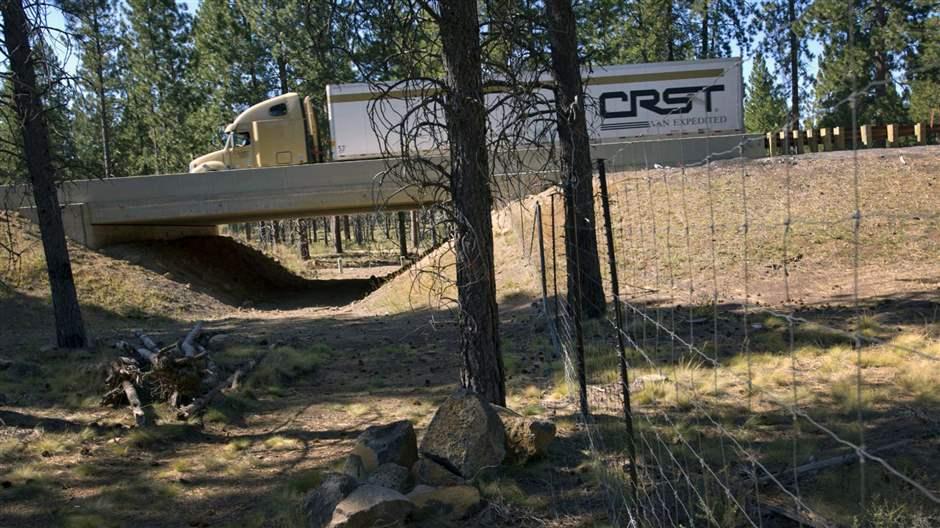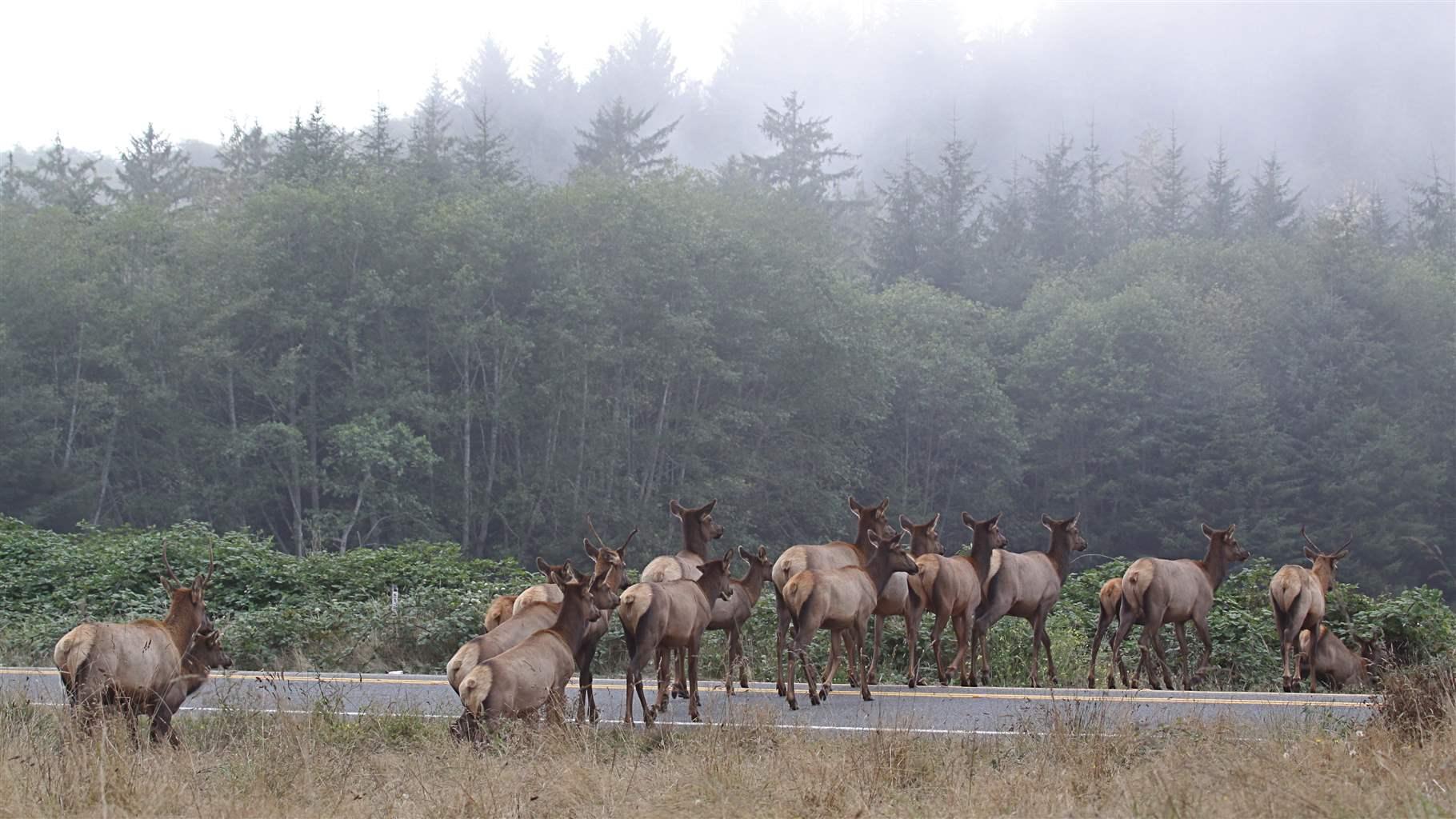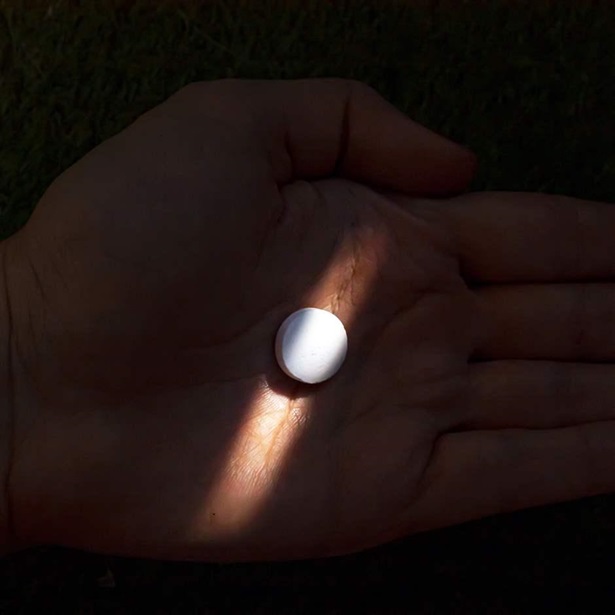Efforts to Help Wildlife Cross a Pacific Northwest Highway Are Working
More animal bridges and underpasses along U.S. 97 would further reduce accidents and save money

From the small lumber town of Weed, California, to the Canadian border, U.S. Highway 97 runs for nearly 670 miles through national forests, lava fields, and farmed valleys, tracking the spine of the West Coast—the Cascade Mountain Range.
The land is prime habitat for myriad species, including elk, mule deer, and pronghorn, that migrate between their summer range on the mountain slopes west of U.S. 97 and their winter home in the warmer high desert east of the road. That means that twice a year, hundreds of thousands of animals cross the increasingly busy U.S. 97 to reach their seasonal ranges.
As a result, wildlife-vehicle collisions kill hundreds of animals each year and cost states millions of dollars. On a 12.5-mile segment in Washington, the state estimates the cost of collisions at more than $2.5 million annually—or $6,500 per collision—in medical care to injured people, vehicle repairs, first-responder expenses, and the value of the animals (to the ecosystem, to the outdoor recreation economy, and more).
Fortunately, purpose-built wildlife crossings and fencing can solve this problem, and California, Oregon, and Washington have each built or are considering such features along some of the most dangerous segments of U.S. 97. Drivers and wildlife need more of those solutions.
California
U.S. 97 begins at a junction with Interstate 5 in Weed and runs northeast through rural Siskiyou County, where GPS collar data collected by the California Department of Fish and Wildlife and the University of California, Davis’ California Roadkill Observation System shows high elk mortality from vehicle collisions. California’s transportation department is considering installing the continent’s first prefabricated fiber-reinforced polymer wildlife bridge along the road. The Western Transportation Institute, which is designing the bridge, believes that broader use of this material could result in less expensive and longer-lasting crossings than concrete or steel, and the bridges might even be relocatable if wildlife movement patterns change. The fencing, sound barriers, and other features on the project will be made from recycled plastic.
Oregon
In Oregon, U.S. 97 is a major corridor and crosses vital mule deer habitat, especially between Klamath Falls and Bend.
The state’s mule deer population has been below the Oregon Department of Fish and Wildlife (ODFW) management goals for at least 30 years and declined by 95,000 animals from 2015 to 2017, in part because of collisions with vehicles and a particularly severe winter.
Collar studies and collision data by ODFW and the Oregon Department of Transportation (ODOT) indicate that U.S. 97 near Gilchrist is a major crossing point for migrating mule deer and elk—and a place where wildlife are extremely vulnerable to vehicle collisions. The state recently finished improving a set of wildlife underpasses and is raising funds to pay for 17 miles of fencing to guide animals toward the structures. Numerous organizations have stepped up, including the Oregon Hunters Association (OHA), the Rocky Mountain Elk Foundation, the Oregon Wildlife Foundation, and The Pew Charitable Trusts, so far raising more than $750,000 of the approximately $1 million needed. The state has also contributed through its new Oregon Conservation and Recreation Fund, which raises primarily small-dollar donations from individuals. And OHA has agreed to provide volunteers to maintain the fencing. Given the breadth of private support for this project, Pew encourages ODOT to cover the small remainder of funds needed for completion.
The Gilchrist crossing is intended primarily for the Fort Rock mule deer herd. Frequent collisions with deer from this herd near Lava Butte prompted the installation of two sets of underpasses there as well—the first large wildlife crossing structures in Oregon—in the early 2000s. The project also includes 30 miles of fencing and vegetation management maintained by the U.S. Forest Service to help animals find the structures, which have reduced vehicle-wildlife collisions along that stretch by more than 85%. A third set of crossings is planned between Gilchrist and Lava Butte at Sunriver.
Washington
In Washington, a broad public-private partnership formed to reduce collisions along a section of Highway 97 in the Okanogan Valley between Riverside and Tonasket, where an average of one mule deer a day is hit by a vehicle.
One crossing and the first mile of accompanying fencing was paid for with $26,000 in private funds when the state was unable to commit money for the project. Partners estimate that that project alone is preventing more than 100 deer collisions a year and helping to keep cougars, bobcats, and other species off the road.
Groups including Conservation Northwest, the Mule Deer Foundation, the Confederated Tribes of the Colville Reservation, and local governments are pushing the state to fund two more phases of the project: The first would place three underpasses along 4.5 miles of road, along with fencing, cattle guards, gates, and other features, at an estimated cost of $8.76 million. That could prevent another 140 collisions a year. The final phase would extend an additional 4.3 miles and include three more undercrossings and fencing. This work is expected to cost $8.81 million and would prevent an additional 105 collisions per year.
Throughout the three states, this work is reducing wildlife-vehicle collisions, improving driver safety, and saving animals’ lives. This could serve as a model for other state and local governments and advocacy groups seeking to address a long-standing problem across the rural American West.
Matt Skroch is a project director and Leslie Duncan is an officer with The Pew Charitable Trusts’ U.S. public lands and rivers conservation team.













